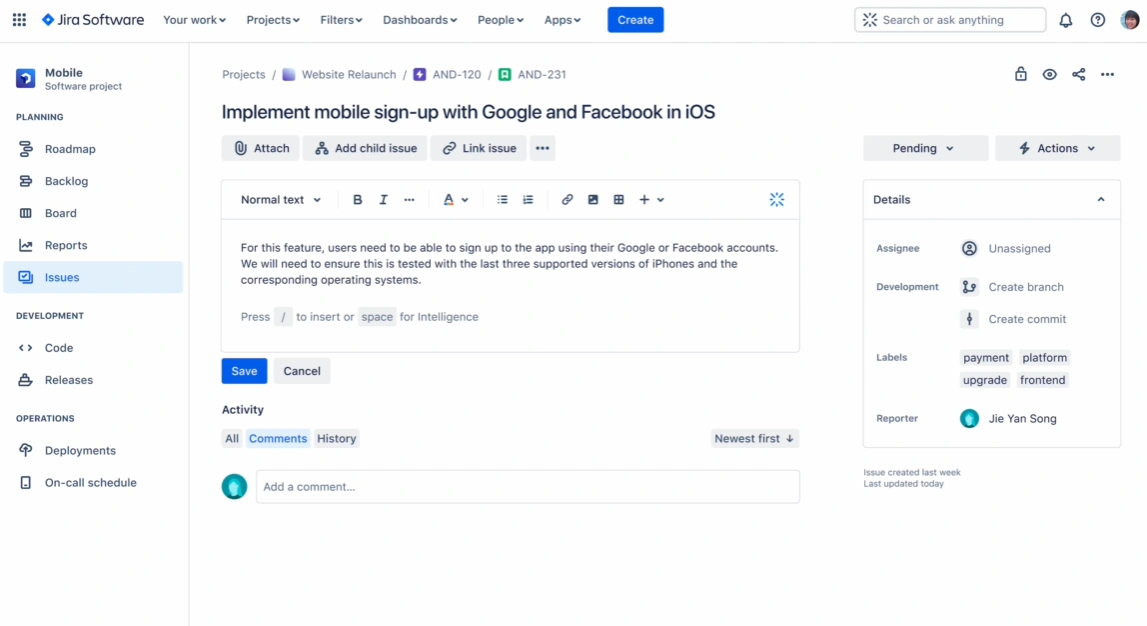Complete Guide to Change Management in Software Development
When it comes to software development, change is not just inevitable, it's essential. Whether it's driven by shifting user needs, new technology, or market trends, managing these changes effectively is key to the success of any software project.
In this comprehensive guide, we'll walk you through the essentials of change management in software development. You'll learn best practices, and tools to help your team adapt to changes, maintain software quality, and keep your projects on track.
What Is Change Management In Software Development
Change management in software development refers to managing changes to software applications or systems in a structured and controlled manner. It aims to ensure changes are effectively integrated into the existing system without causing disruptions or introducing errors.
Why Should We Manage Change In Software Development
Requirements can evolve, new technologies emerge, and unexpected issues arise, so change management is essential to navigate these changes while maintaining the project's quality, stability, and success.
By implementing a robust change management process, organizations can:
- Ensure Quality: Changes can introduce new defects or errors. A well-defined change management process helps prevent these issues by ensuring that changes are implemented correctly and thoroughly.
- Reduce Costs: Uncontrolled changes can lead to rework, delays, and increased costs. By managing changes proactively, organizations can minimize these expenses.
- Mitigate Risks: Change management helps identify and address potential risks associated with changes, reducing the likelihood of negative consequences.
- Improve Customer Satisfaction: A stable and reliable product is crucial for customer satisfaction. Effective change management contributes to a more predictable and consistent product, enhancing customer experience.
- Enhance Productivity: A streamlined change management process can improve the efficiency of development teams, allowing them to work more productively.
Source of Changes
Sources of changes in software development can come from various factors. Here are some key sources of changes:
1. User Feedback
End-users often provide feedback after using the software, highlighting issues, suggesting new features, or requesting enhancements. This feedback is a critical source of changes, as it directly reflects user needs and helps improve the software's usability and functionality.
2. Bug Reports
Identified defects or bugs in the software, whether found during testing or after deployment, necessitate changes to correct the errors and improve system stability.
3. Market Demands
Shifts in the market, such as new technologies, trends, or competition, can drive the need for changes to keep the software relevant and competitive.
4. Regulatory Compliance
Changes in laws, regulations, or industry standards may require updates to the software to ensure it remains compliant, especially in sectors like healthcare, and data protection.
5. New Feature Development
As the business evolves, new features are often added to the software to expand its capabilities, meet new business requirements, or enter new markets.
6. Hardware or Software Upgrades
Updates to the underlying hardware, operating systems, or third-party software dependencies can necessitate changes to ensure compatibility and leverage new features or performance improvements.

7. Security Vulnerabilities
Emerging security threats often require prompt changes to the software to patch vulnerabilities and protect the system from potential attacks.
What is a Change Advisory Board (CAB)?
A Change Advisory Board (CAB) is a group of individuals responsible for reviewing, approving, or rejecting proposed changes to a system or process. The CAB typically consists of representatives from various departments or functions within an organization, such as IT, operations, finance, and legal.
The primary purpose of a CAB is to ensure that changes are aligned with the organization's goals, prioritize changes based on their importance and impact, and mitigate potential risks associated with the changes. CABs often have the authority to approve or reject changes, and they may also provide guidance and oversight during the implementation process.
Key Roles and Responsibilities of a CAB:
- Reviewing change requests
- Prioritizing changes
- Assessing risks
- Approving or rejecting changes
- Providing guidance
A Change Advisory Board (CAB) is a crucial component of effective change management, particularly in organizations with complex systems, high-risk changes, or strict regulatory requirements.
By providing a centralized point of control, the CAB can help ensure that changes are evaluated, prioritized, and approved in a consistent and controlled manner. However, in smaller organizations with simple systems/ processes or low-risk changes, A CAB may not be necessary, as changes can be managed more informally.
The Change Management Process
The change management process is a structured approach to implementing changes in an organization. There are 6 main steps in the change management process.
- Step 1: Change Request
- Step 2: Change Impact Assessment
- Step 3: Change Authorization
- Step 4: Change Implementation
- Step 5: Change Verification
- Step 6: Change Closure
Let's explore what we need to do in each step below:
Step 1: Change Request
First of all, a change request is submitted. The request will outline the proposed change, its rationale, and the expected benefits. Next, the request is evaluated to determine its feasibility, impact, and alignment with organizational goals.
Step 2: Change Impact Assessment
At this step, we will analyze the potential consequences of the change including its effects on resources, timelines, risks, and dependencies.
Step 3: Change Authorization
The change request will be reviewed and approved or rejected by a designated authority. After that, the decision is communicated to stakeholders involved in the change.
Step 4: Change Implementation
A detailed plan is created outlining the steps, resources, and timelines required to implement the change. Next, the change is implemented according to the plan, ensuring adherence to quality standards and best practices.
Step 5. Change Verification
The change is tested to ensure it meets the specified requirements and does not introduce new defects. Then, the change is validated to confirm that it achieves the desired outcomes.
Step 6: Change Closure
The change is documented, including the final implementation details and lessons learned. AT this time the change request is officially closed, and the project or initiative can proceed with the updated configuration.
Challenges in Change Management
Change management, while essential for organizational growth and adaptation, often faces significant challenges. Here are five common hurdles:
1. Scope Creep
Scope creep, the tendency for projects to expand beyond their original boundaries, is a common challenge. Uncontrolled scope creep can lead to delays, increased costs, and decreased quality. To prevent scope creep, it's essential to have a clear project scope, establish change control processes, and regularly review and adjust the scope as needed.
2. Insufficient Communication
Poor communication can hinder change management efforts. Misunderstandings, lack of clarity, and inadequate information can lead to confusion, resistance, and delays. Effective communication involves clear messaging, open dialogue, and active listening.

3. Lack of Resources
Insufficient resources, including budget, personnel, or technology, can hamper change implementation. Without adequate resources, it can be difficult to allocate time, effort, and expertise to the change initiative. To address this challenge, organizations need to carefully assess resource requirements, prioritize changes, and allocate resources accordingly.
4. Unexpected Risks
Even with careful planning, unexpected risks can arise and derail change initiatives. These risks may include technical difficulties, regulatory changes, or unforeseen external factors. To reduce risks, organizations should carefully assess potential risks, create backup plans, and monitor the environment for potential threats. By proactively addressing these challenges, organizations can increase the likelihood of successful change implementation and achieve their desired outcomes.
Best Practices for Effective Change Management
By following these best practices, organizations can increase the likelihood of successful change implementation, minimize disruptions, and achieve their desired outcomes.
Planning and Preparation
- Change Impact Assessment: Conduct a thorough assessment to understand the potential consequences of the change, including its effects on resources, timelines, risks, and dependencies.
- Communication Plan: Develop a comprehensive communication plan to inform stakeholders about the change, address concerns, and provide updates throughout the process.
- Resource Allocation: Ensure adequate resources, including budget, personnel, and technology, are allocated to support the change initiative.
Implementation
- Change Control Board (CAB): Establish a CAB to review and approve or reject proposed changes, ensuring they align with organizational goals and minimize risks.
- Version Control: Implement a version control system to track changes to the software or system and maintain a history of modifications.
- Testing and Quality Assurance: Rigorously test the changes to ensure they meet the specified requirements and do not introduce new defects or issues.
- Training and Support: Provide necessary training to affected employees and offer ongoing support to help them adapt to the changes.
Monitoring and Evaluation
- Post-Implementation Review: Conduct a thorough review after the change is implemented to assess its effectiveness, identify lessons learned, and make necessary adjustments.
- Continuous Improvement: Regularly review and refine the change management process to improve its efficiency and effectiveness.
- Lessons Learned: Document and share lessons learned from the change to inform future initiatives and avoid repeating mistakes.
Tools and Technologies for Change Management
Change management can be significantly enhanced through the use of various tools and technologies. These tools can streamline processes, improve communication, and provide valuable insights into the change initiative. Here are some key tools and technologies:
Version Control Systems (VCS)
- Git: The most popular VCS, known for its speed, efficiency, and distributed nature.
- SVN (Subversion): A centralized VCS with a long history and strong community support.
- Mercurial: Another distributed VCS with a focus on simplicity and ease of use.
Issue Tracking and Bug Reporting Tools
- Jira: A versatile tool for managing issues, bugs, and tasks across teams.
- Bugzilla: A free and open-source bug tracking system.
- Trello: A visual task management tool that can be used for agile development.

Continuous Integration and Continuous Delivery (CI/CD) Pipelines
- Jenkins: A popular open-source CI/CD server.
- GitLab CI/CD: Integrated CI/CD capabilities within GitLab.
- CircleCI: A cloud-based CI/CD platform.
Configuration Management Tools
- Ansible: A simple and powerful configuration management tool.
- Puppet: A well-established configuration management platform.
- Chef: A popular configuration management tool with a strong focus on infrastructure automation.
Collaboration and Communication Tools
- Slack: A popular team messaging and collaboration platform.
- Microsoft Teams: A collaboration hub that integrates with other Microsoft tools.
- Zoom: A video conferencing tool for remote teams.

Change Management Software
- ChangeGear: A dedicated change management solution for IT organizations.
- BMC Change Management: A comprehensive change management platform.
- ServiceNow: A cloud-based platform that includes change management capabilities.
Wrap Up!
Navigating change is a constant in the software development landscape. By mastering change management, teams can ensure that every update, improvement, or feature addition is handled with precision, minimizing disruptions and maximizing positive outcomes. This guide has provided you overview of change management and best practices to effectively manage change, from understanding the sources of changes to implementing them smoothly and communicating with stakeholders.
As you apply these principles, you'll find that change management isn't just about mitigating risks, it's about driving your projects forward, adapting to new challenges, and continually improving the quality of your software. Embracing change with a structured approach will not only help you meet your current project goals but also equip your team to thrive in the dynamic world of software development.





